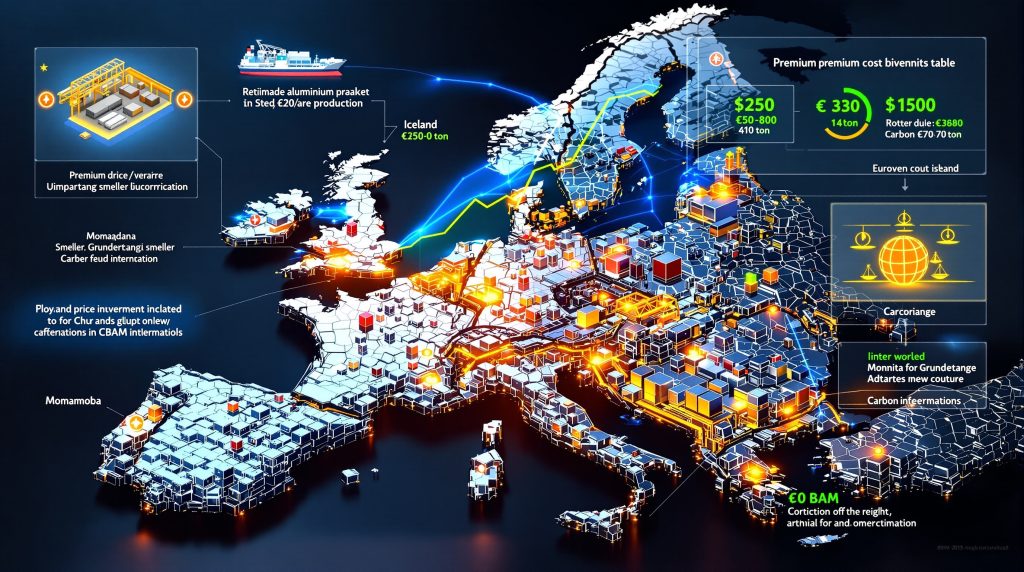The European aluminum duty-paid premium represents the additional cost above London Metal Exchange (LME) prices that physical market buyers must pay to secure aluminum within European markets. This premium encompasses import duties, transportation expenses, handling fees, and increasingly, carbon-related charges that reflect the true cost of bringing aluminum to European warehouses. Furthermore, understanding how tariffs impact regional pricing mechanisms becomes essential for market participants.
Understanding this premium structure is crucial for market participants as it directly impacts aluminum procurement costs across the continent. The duty-paid premium serves as a critical pricing mechanism that bridges the gap between global commodity prices and regional market realities, incorporating the full spectrum of costs required to deliver physical aluminum to European industrial consumers.
Core Components of Premium Calculations
The premium calculation incorporates multiple cost elements that vary based on market conditions and regulatory requirements. Import duties form a significant portion, protecting regional producers while generating revenue for European governments. Transportation costs fluctuate based on shipping routes, fuel prices, and geopolitical disruptions affecting major trade lanes.
Handling and storage costs reflect the operational expenses of warehouse facilities, including labour, insurance, and facility maintenance. With the introduction of the Carbon Border Adjustment Mechanism in 2026, carbon-related charges will become an increasingly important component, fundamentally altering the premium structure for aluminum imports from different production regions.
How Have European Aluminum Premiums Evolved Throughout 2025?
Premium levels have demonstrated remarkable volatility throughout 2025, reflecting the dynamic nature of European aluminum markets. The year began with elevated pricing as supply constraints and strong demand created upward pressure on regional premiums. Market participants witnessed unprecedented swings that highlighted the sensitivity of European aluminum pricing to both supply disruptions and regulatory changes.
According to Reuters reporting from November 12, 2025, early in the year premiums reached elevated levels, representing substantial increases compared to previous periods. This pricing environment reflected tight supply conditions and strong industrial demand across key consuming sectors in Europe.
Mid-Year Market Correction
The second quarter brought significant relief to aluminum buyers as market conditions shifted dramatically. Premium levels experienced substantial declines, falling to their lowest point in over twelve months. This correction demonstrated the aluminum market's capacity for rapid price adjustment when supply-demand fundamentals change.
The decline occurred as supply constraints eased temporarily and demand from key industrial sectors moderated. Construction and automotive industries, major aluminum consumers, faced headwinds that reduced their raw material procurement, contributing to the premium correction.
Current Premium Landscape
As reported by Reuters on November 12, 2025, the European aluminum duty-paid premium currently stands at $324 per metric ton. The premium reached $330 on November 3, marking the highest level since late January and demonstrating renewed upward pressure on regional pricing.
This recent strength reflects multiple factors converging to support premium levels. Supply disruptions, carbon tax preparation activities, and freight cost pressures have combined to create a supportive environment for European aluminum premiums heading into the final quarter of 2025. Moreover, the broader industry evolution trends continue to shape these market dynamics.
What Supply Disruptions Are Currently Affecting European Aluminum Markets?
European aluminum supply chains face significant disruption from multiple sources, creating upward pressure on regional premiums and forcing buyers to seek alternative supply arrangements. The most impactful disruption stems from Iceland, traditionally a major supplier to European markets.
Iceland Smelter Crisis Impact
The 320,000-ton-per-year Grundartangi smelter in Iceland experienced a critical electrical equipment failure in late October 2025, according to Reuters reporting. This disruption reduced production capacity by approximately two-thirds, representing a loss of roughly 213,000 tons of annual production capacity.
Century Aluminum CEO Jesse Gary, speaking on an earnings call reported by Reuters, indicated that recovery could take 11-12 months for replacement transformer manufacturing and installation. However, the timeline could potentially be shortened if existing failed transformers can be successfully repaired rather than replaced entirely.
The significance of this disruption cannot be overstated given Iceland's position as the EU's second-largest aluminum supplier. During the first eight months of 2025, Iceland shipped 241,412 tons to European markets, making the Grundartangi outage a substantial supply shock for the region.
Shifting Supply Source Dependencies
With Iceland's reduced capacity, European buyers are increasingly dependent on alternative suppliers. Mozambique emerged as the largest supplier to the EU during the first eight months of 2025, shipping 337,670 tons to the bloc according to Reuters data.
This supply concentration creates vulnerability to further disruptions and supports premium levels. The shift demonstrates how quickly aluminum supply chains must adapt to production outages, with buyers scrambling to secure alternative sources often at higher costs.
The geographic concentration of supply sources exposes European markets to transportation risks, particularly given ongoing disruptions in key shipping lanes that affect freight costs and delivery times.
How Will the Carbon Border Adjustment Mechanism Transform European Aluminum Pricing?
The implementation of the Carbon Border Adjustment Mechanism (CBAM) represents the most significant structural change to European aluminum pricing in decades, fundamentally altering how premiums are calculated and applied across the region. This policy initiative aims to create carbon pricing parity between domestic and imported aluminum production, reflecting the broader energy transition dynamics affecting global markets.
CBAM Integration Timeline
According to Reuters reporting from November 12, 2025, CBAM will formally come into force on January 1, 2026, though actual carbon price payments will not be required until 2027. This implementation follows a two-year transition period that allowed importers to prepare for the new regulatory requirements.
The mechanism will be directly embedded into duty-paid premium assessments, similar to existing import duty structures. This integration affects key benchmarks including Rotterdam in-warehouse assessments and regional evaluations for Italy and Spain, fundamentally changing how aluminum pricing is structured across European markets.
Carbon Cost Variations by Origin
Nick Ogilvie, CBAM lead at CarbonChain, explained to Reuters that the carbon charge depends on the emissions of the aluminum smelter behind the metal, aiming to put a fair price on carbon emitted during production. The cost variations by production source create significant competitive advantages and disadvantages.
Aluminum produced by many Middle Eastern and Canadian smelters will face relatively small costs of 10-50 euros per ton because of their low direct emissions intensity. These producers benefit from cleaner energy sources and more efficient production technologies that minimise carbon footprints.
Conversely, smelters using older, high-emission technologies face substantially higher CBAM charges. As Ogilvie noted to Reuters, "there are smelters whose products are unlikely to be coming to the EU anymore because they are using very old technology", suggesting carbon costs could exceed 100-200 euros per ton for the most emission-intensive producers.
EEA producers including Norway and Iceland remain exempt from CBAM charges, creating a significant competitive advantage for these regional suppliers in European markets.
Market Adaptation Strategies
Edgardo Gelsomino, Wood Mackenzie aluminum research director, told Reuters that importers are implementing front-loading strategies, accelerating aluminum purchases ahead of CBAM implementation. This behaviour is driven not only by avoiding carbon costs but also by reducing administrative burden associated with the new regulation.
This front-loading activity contributes to current premium strength and may create supply tightness in early 2026 as the market adjusts to new pricing structures. The behavioural response demonstrates how regulatory changes create market distortions even before full implementation.
What Factors Are Driving Current Premium Volatility?
European aluminum premiums reflect a complex interplay of supply-demand fundamentals, regulatory changes, and macroeconomic pressures that create ongoing price volatility. Understanding these factors is crucial for market participants seeking to navigate the increasingly complex European aluminum market.
Demand-Side Pressures
End-user sectors face significant margin compression, limiting their ability to absorb higher aluminum costs. Construction and automotive industries, major aluminum consumers, confront headwinds from elevated interest rates and softening market conditions that reduce their raw material demand.
The construction sector, particularly sensitive to interest rate environments, has reduced aluminum consumption for building materials and infrastructure projects. Similarly, automotive manufacturers face production slowdowns that directly impact aluminum demand for vehicle manufacturing.
This demand weakness creates downward pressure on premiums during periods when supply disruptions are not dominating price formation, contributing to the volatility observed throughout 2025.
Freight Cost Dynamics
Red Sea shipping disruptions and Houthi rebel attacks have substantially elevated ocean freight costs, as vessels must navigate longer alternative routes around the Cape of Good Hope. These disruptions increase transit times and vessel operating costs, directly impacting aluminum import expenses.
While these elevated freight costs support premium levels in the short term, their gradual decline is expected to create downward pressure on premiums as shipping conditions normalise. The temporary nature of these disruptions means their impact on premium structure may prove temporary.
The additional voyage time and bunker fuel consumption associated with Cape of Good Hope routing creates quantifiable cost increases that are passed through to aluminum buyers via higher premiums.
Secondary Production Constraints
European secondary aluminum producers are reducing billet production amid high input costs for scrap and ingots. This production curtailment provides upside support to premiums by tightening regional supply availability, creating a supply-side support mechanism.
High scrap aluminum prices make secondary production less economical, forcing producers to reduce output and contributing to overall supply tightness. This dynamic supports premium levels by reducing alternative supply sources for European consumers.
The secondary production constraints demonstrate how cost pressures ripple through the aluminum supply chain, affecting multiple production methods and supporting premium levels through reduced total supply availability.
How Do Futures Markets Help Manage European Aluminum Premium Risk?
Financial markets provide sophisticated tools for managing the price risk associated with European aluminum premiums, allowing market participants to hedge against regional pricing volatility. These instruments have become increasingly important as premium volatility has increased due to supply disruptions and regulatory changes.
CME Futures Contract Structure
The CME Group offers Aluminum European Premium Duty-Paid (EDP) futures contracts that provide cash-settled risk management against Metal Bulletin aluminum premium indices. These contracts trade on CME Globex and CME Direct platforms, providing accessible hedging opportunities for international market participants.
The futures contracts allow market participants to lock in future premium levels, providing price certainty in an increasingly volatile market environment. Contract specifications include standardised lot sizes and delivery months that accommodate various hedging timeframes. Consequently, traders can implement sophisticated commodity trading strategies using these instruments.
Risk Management Applications
Different market participants utilise these futures contracts for distinct risk management purposes:
-
Importers: Lock in premium costs to protect against upward price movements during supply disruptions
-
Producers: Secure regional pricing advantages through forward sales of aluminum to European markets
-
Traders: Arbitrage premium differentials between regions and time periods for profit opportunities
-
End-Users: Achieve budget certainty for aluminum procurement costs in manufacturing operations
The hedging applications demonstrate how financial instruments help transfer price risk from commercial participants to speculative capital, improving overall market efficiency and price discovery.
What Regional Variations Exist Within European Aluminum Premiums?
European aluminum markets demonstrate significant regional pricing variations that reflect local supply-demand dynamics, transportation costs, and market structures across different countries and regions. These variations create arbitrage opportunities and complicate procurement strategies for multinational companies.
Key Regional Benchmarks
Rotterdam serves as the primary European benchmark for duty-paid premiums due to its strategic port location and substantial warehouse infrastructure. However, regional markets maintain their own premium structures that reflect local conditions and consumption patterns.
Italian markets reflect Mediterranean supply patterns and consumption from the country's substantial aluminum-intensive manufacturing sector. Spanish markets maintain specific evaluations for Iberian Peninsula demand, influenced by local industrial activity and import logistics.
German markets represent Central European pricing influenced by the country's substantial industrial aluminum demand from automotive and manufacturing sectors. Each regional market maintains distinct characteristics that create pricing variations from the Rotterdam benchmark.
Transportation and Logistics Factors
Regional premium variations reflect the cost and complexity of moving aluminum from primary entry points to final consumption locations. Inland transportation costs vary significantly based on distance, infrastructure quality, and local logistics capabilities.
Warehouse availability and storage costs differ across regions, with some markets maintaining substantial inventory buffers while others operate with minimal stock levels. Local market liquidity also contributes to regional pricing differentials, with some markets supporting active trading while others remain relatively illiquid.
These logistics factors create structural premium differences that persist even when underlying supply-demand fundamentals are similar across regions.
How Do European Premiums Compare to Global Aluminum Pricing Structures?
European aluminum premiums exist within a global context of regional pricing mechanisms, each reflecting local market conditions, regulatory environments, and supply-demand fundamentals. Understanding these comparative structures helps illuminate the unique characteristics of European aluminum pricing.
Global Premium Comparison Framework
Different regions maintain distinct premium structures based on their specific market characteristics:
United States Midwest premiums typically range $200-350 per ton, driven by transportation costs from primary production centres and tariff structures that protect domestic production. The US market benefits from substantial domestic production capacity that reduces import dependency.
Japanese CIF premiums generally range $150-250 per ton, reflecting the country's import logistics and established supply relationships with major producing regions. Japan's premium structure benefits from efficient port infrastructure and established trading relationships.
Southeast Asian premiums typically maintain the lowest levels globally at $100-200 per ton, reflecting regional supply surplus and proximity to major production centres in the region.
Convergence and Divergence Patterns
Global aluminum premiums tend to move in similar directions during major supply disruptions or demand shifts, demonstrating the interconnected nature of global aluminum markets. However, regional factors can create significant divergence during periods of localised disruptions.
European premiums often trade at elevated levels due to regulatory complexity, particularly with CBAM implementation, and transportation costs associated with import dependency. The regulatory burden creates structural cost differences that separate European pricing from other global markets.
Currency fluctuations also influence regional premium relationships, with exchange rate movements affecting the relative attractiveness of different supply sources and regional markets.
What Investment and Trading Implications Arise from Premium Dynamics?
European aluminum premium movements create significant implications for investors, traders, and companies involved in aluminum-related activities across the value chain. Understanding these implications is crucial for developing effective strategies in the evolving aluminum market. Furthermore, those considering exposure to aluminum markets should explore comprehensive ETC investment guide resources.
Producer Strategy Considerations
Aluminum producers with European exposure benefit from elevated premiums, which improve regional profitability and may influence production allocation decisions. Companies with smelting operations in EEA countries gain competitive advantages under CBAM implementation.
Norwegian and Icelandic producers, exempt from CBAM charges, enjoy structural advantages that could support long-term market share gains in European markets. These producers can offer competitive pricing while maintaining margins, creating strategic positioning opportunities.
Production allocation decisions increasingly consider premium levels alongside base metal prices, with producers directing output to regions offering the most attractive total pricing packages.
Consumer Impact Analysis
Downstream aluminum consumers face margin pressure from elevated premiums, potentially affecting multiple industrial sectors:
Automotive manufacturers confront higher input costs for vehicle production, particularly affecting lightweight vehicle designs that utilise substantial aluminum content. Premium volatility complicates procurement budgeting and supply chain management.
Construction companies experience increased material costs for building projects, particularly those utilising aluminum curtain walls, windows, and structural components. Premium increases may delay project timelines or force material substitution.
Packaging industries face rising costs for aluminum containers and foil production, potentially affecting consumer goods pricing and packaging material selection decisions.
Aerospace sector experiences premium impacts on specialised aluminum alloys, though this sector typically demonstrates less price sensitivity due to performance requirements.
Trading Opportunities
Premium volatility creates multiple trading opportunities for sophisticated market participants:
Arbitrage strategies exploit price differentials between regions, with traders buying aluminum in lower-premium markets and selling in higher-premium regions. Geographic arbitrage becomes more attractive as premium differentials widen.
Timing strategies involve optimising purchase timing around premium cycles, with buyers accelerating purchases before anticipated premium increases and delaying purchases when declines are expected.
Hedging programmes utilise futures markets to manage price risk, allowing companies to lock in favourable premium levels for future delivery periods. These programmes become more valuable as premium volatility increases.
Storage plays capitalise on temporal price differences, with traders storing aluminum during low-premium periods for sale during high-premium periods. This strategy requires careful consideration of carrying costs and storage logistics.
The increasing complexity of European aluminum markets, driven by regulatory changes and supply disruptions, creates enhanced opportunities for informed market participants while increasing risks for those unprepared for the evolving market structure.
Disclaimer: This analysis is for informational purposes only and should not be considered investment advice. Aluminum markets involve substantial risks, and past performance does not guarantee future results. Readers should conduct their own research and consult with qualified professionals before making investment decisions.
Want to Capitalise on Commodity Market Volatility?
Discovery Alert's proprietary Discovery IQ model delivers real-time alerts on significant ASX mineral discoveries, instantly empowering subscribers to identify actionable opportunities whilst complex market dynamics like European aluminum premiums create trading volatility across global commodity markets. Begin your 30-day free trial today and secure your market-leading advantage in an increasingly interconnected commodities landscape.




